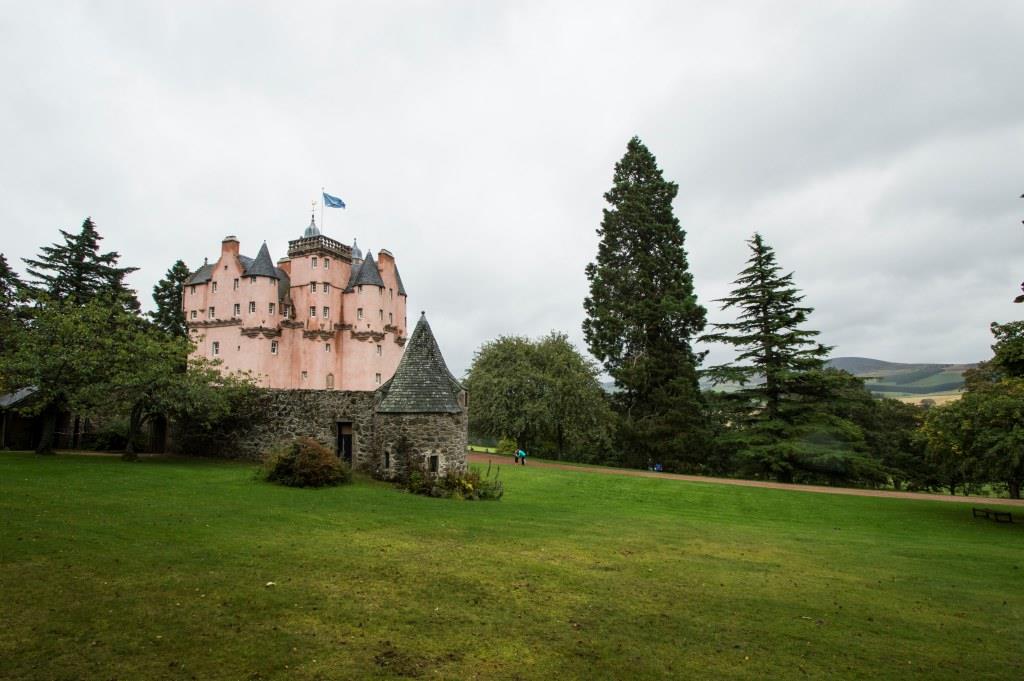Craigievar Castle

Craigievar Castle Details
Craigievar Castle, an elaborate C17 tower house of the Forbeses with original plaster ceilings. National Trust for Scotland.
- Closest To: Torphins, Lumphanan, Alford, Tarland
- Access: Chargeable Public Access
- Grid Reference: NJ567095
Craigievar Castle is to many the quintessential Scottish tower house, and is certainly one of the most striking in appearance with bold pink harling, although this is not the original colouring. Inside, the castle is equally striking, with intricate plaster ceilings dating from the 17th century.
The castle was originally built by the Mortimer family, who had held the Craigievar estate since at least 1376, and is normally said to date from the period 1575-1595, and to the time of the last two Mortimer lairds, John and James. The Mortimers were close associates of the Gordon family, and perhaps their fortunes suffered during the religious troubles of the Reformation. Certainly by 1610 they were no longer able to support themselves, and in that year James Mortimer sold the Craigievar estate to William Forbes, a wealthy merchant from the family who were at feud with the Gordons.
It is said that the castle was in a state of disrepair at this time, or incomplete, and that Forbes completed the castle. However it does seem possible to me that the castle had been damaged, possibly burned out, and that Forbes repaired it. Certainly he commenced a work of architectural magnificence. It is also possible that parts of Craigievar incorporate older work of the Mortimers, it seeming unlikely that they would not have had a residence at the site since they had been Barons of Craigievar since the late 14th century.
The castle is an L-plan tower house with a rectangular hall-block and a slightly offset square tower. In the angle between the two is a secondary square tower which contains the front door. On the 1st and 2nd floors the hall block is dominated by a single large hall filling both halls, but at 3rd floor level and above this is divided by a stone wall which means that on the top (5th) floor a large single room extends from the wing over one half of the hall – clearly reflecting the different build phases. A complex arrangement of corbelled turrets provide many watch towers, and some of these contain staircases.
Undoubtedly the highlight of Craigievar is the plastered ceilings which survive in the Hall – still entered through the original screened passage – and the main bedrooms, but the stark white plaster is a vivid contrast to the pink harling outside and gives a very cold feeling. This was a fashion started by James VI in 1617, and can be contrasted with nearby Crathes, which contains painted ceilings, a fashion of the previous generation.
William Forbes’ son was made the first Baronet Forbes of Craigievar, and showed King Charles scant thanks for his title by becoming an active supporter of the Covenanters; it is likely that his son Sir John, and grandson Sir William carried out further improvements to the castle between 1648 and 1725, but no evidence remains to show who was responsible for such work as the wooden panelling. In fact it is only in 1776 that records survive relating to the blocking of 24 windows, a clear reference to an attempt to reduce the window tax payable. The fortunes of the family declined, and although Craigievar Castle was maintained, the family had moved out. A substantial repair programme was commenced in the 1820s, which was when the castle was reharled pink rather than the off-white it had previously been. By this time most of the courtyard and ranges surrounding it had also been demolished, leaving the castle much as it is today.
Craigievar Castle was eventually sold to the National Trust for Scotland, and is open to the public.
Official National Trust for Scotland page
Become a supporter of my work to access a more detailed history